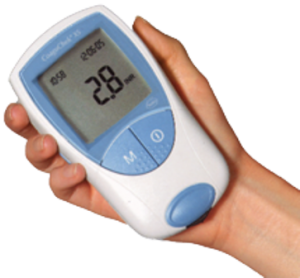INR self-monitoring Campaign
The campaign for the provision of INR machines continues, if you would like to be involved or support the campaign email info@chfed.org.uk.
Background
- Warfarin is an anticoagulant (blood thinner).

- It is used to stop the blood from clotting too easily.
- It also prevents harmful clots from forming and getting bigger in the blood.
- If blood is too thick or too thin, it can cause a stroke.
There are two types of stroke:
1. ischaemic (clot) which is caused by a blockage cutting off the blood supply to the brain. The blockage can be caused by a blood clot forming in an artery leading to the brain or within one of the small vessels deep inside the brain;
2. haemorrhagic (bleed) which is caused when a blood vessel bursts within or on the surface of the brain. Because blood leaks out into the brain tissue at high pressure, the damage caused in a haemorrhagic stroke can be greater than the effects caused by strokes due to a blockage cutting off the blood supply to the brain.
- About 85% of all strokes are ischaemic and 15% haemorrhagic.
- Stroke occurs in up to 13 per 100,000 children in the UK.
- That is about 400 childhood strokes a year in the UK.
- 1 in 4,000 babies have a stroke at birth worldwide – which means that about 200 babies in the UK have a stroke.
- Heart disorders cause up to 25% of ischaemic strokes in children
The National Institute for Health and Care Excellence (NICE) Guidance
- It is important therefore, that people who take warfarin monitor their INR levels (clotting levels).
- Often this means that they need to go to hospital or sometimes visit their GP, to be tested.
However, it is possible to use a self-testing coagulometer to do the tests at home.
The National Institute for Health and Care Excellence (NICE) reviewed two coagulometers that monitor blood clotting in people taking long-term anti-blood clotting drugs (such as warfarin) to reduce their risk of blood clots.
These tests allow people taking anti-blood clotting drugs to monitor blood clotting themselves. They can then change their dose in agreement with their health professional.
In Diagnostics Guidance 14 (DG14) NICE recommended:
- the coagulometers for use by people taking long-term anti-blood clotting therapy who have atrial fibrillation or heart valve disease, if they prefer and are able to effectively self-monitor.
- that people (and their carers) who will be using either of these devices should be given training and their doctor should regularly assess self-monitoring.
Continuing the INR Self-monitoring Campaign
Sadly, few hospital trusts or GP practices are complying with DG14 and so CHF along with the members of ACSMA are continuing to campaign for:
- NHS service commissioners and providers to look at how anticoagulation services can be redesigned and liberated from the hospital and primary care clinics so as to ensure that – wherever possible – all suitable patients are given the choice to self-monitor their INR levels, should they wish to and are competent to do so;
- Clinical Commissioning Groups (CCGs) providing information on self-monitoring for both patients and healthcare;
- NHS England to address the disconnect between national government policies that are supportive of greater self-management and choice for people as opposed to the poor implementation of those policies at local NHS level;
- Appropriate support and encouragement to be given to those who are successfully self-monitoring to do so; including being allowed to receive test strips on NHS prescription.
CHF has – subject to funding – been a major provider of INR machines to families that meet the referral criteria.
We hear countless stories of families having to make long journeys, week in week out, simply to conduct a short INR test which they could, with appropriate support, carry out at home. The expense of travel, the disruption to parents’ work, and disturbance to the child’s schooling, as well as the long and sometimes difficult journeys could all be minimised or prevented if the NICE Guidance is followed and all patients who meet the criteria are provided with an INR machine on prescription.
That is why, on behalf of all the families who could benefit, we ask you to support this important and vital campaign.
If you are having difficulty getting an INR machine please contact CHF via: info@chfed.org.uk.
State of the Nation, Stroke Statistics published by the Stroke Association Jan 2016
Further information:
NICE Diagnostic Guidance [DG14]
https://www.nice.org.uk/guidance/dg14
Why this campaign is so important to families:
If you have a story to tell about the benefits of an INR machine to a child on anticoagulants email the details to info@chfed.org.uk it will help the campaign greatly.
Katherine’s Story
Katherine from Surrey was born with a heart condition called Pulmonary Atresia. She had to have major life-threatening open heart surgery when she was 7 years old and has been battling her condition ever since.
Rachel, Katherine’s mum said, “Taking her for the blood tests over the years has been pretty harrowing, there is no reasoning with a terrified, crying child who is begging you not to have it done. Having it done at home is so much easier; we’re so lucky to now have a machine. It’s safe, easy and practical – it revolutionises your whole life”.
Katherine said, “I’m so grateful we had a machine to monitor my INR at home. During GCSEs we didn’t have the disruption of having to go to the hospital for every check – exams are hard enough without having to take time out. Not having it would have meant I would have had to miss assessments, deadlines maybe even exams. It would have really affected my results and my whole future”.









